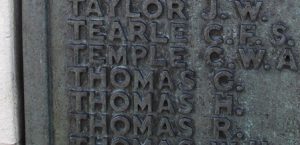Carrog is a village situated three miles east of Corwen. The village was situated within the ancient county of Merionethshire until 1974, when the borders of the Welsh counties were moved, and it was placed within the county of Clwyd. The village now lies within the county of Denbighshire, but as the men on the memorial lived in Merionethshire, the memorial is under that section of this website. The men of the village who fell in both World Wars are commemorated on the village war memorial, which was dedicated following the Great War, and contained ten names. The names of the three villagers who fell during World War 2 were added following the end of that war. The memorial is made of marble and is located in an unusual location, being built into a wall near a junction on the B5437 road near to the Church gates.
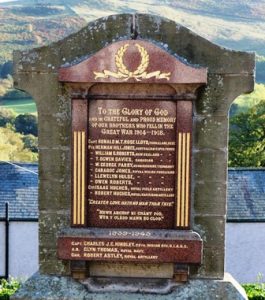
The Great War, 1914-1918
Thomas Ogwen Davies, Private, 624817, Canadian Infantry. Thomas was born at Carrog on 12 August 1897, the son of William Thomas Davies, and Marie Davies (nee Griffiths). He emigrated to Canada following the death of his parents and worked as a farmer. Thomas enlisted at Wetaskiwin, Alberta into the 151st Overseas Battalion, Canadian Expeditionary Force on 16 February 1916. The battalion sailed from Canada for England on 3 October 1916. On 13 November 1916 Thomas was posted to France, joining the 8th Battalion, Canadian Infantry (Little Black Devils), which was attached to the 2nd Brigade, 1st Canadian Division. The Division had seen heavy fighting on the Somme, and moved to the Arras sector, to prepare for the forthcoming Battle of Arras, and famously took part in the capture of Vimy Ridge from 9 April 1917. On 25 July 1917 Thomas was admitted to No 10 General Hospital at Rouen after being wounded in the thigh. He returned to duty a month later, re-joining the 8th Battalion in the area north of Arras, near the village of Aix-Noulette. On 21 September 1917 the 8th Battalion relieved the 10th Battalion in the front line nearby. Thomas was killed in action by German artillery soon after the relief. He was 20 years old and is buried in Aix-Noulette Communal Cemetery Extension, France.
James Louis Dykins, Private, 60468, Cheshire Regiment. James was born in Manchester on 16 July 1898, the son of James and Elizabeth Dykins. The family was living at Tirllanerch Cottage, Carrog prior to the war. James enlisted at Liverpool into the Cheshire Regiment, and was posted to France in 1917, joining the 10th Battalion, Cheshire Regiment, which was attached to 7 Brigade, 2nd Division. During March 1917 the Division followed the German Retreat to the Hindenburg Line, and in April they fought at Arras, during the First Battle of the Scarpe, the Battle of Arleux and the Third Battle of the Scarpe. The Divisions next major action was at the Battle of Cambrai later that year, but James is recorded as having died of wounds at Ypres on 31 August 1917, aged 20. His unit was not at Ypres, so he must have been attached to another battalion. James is buried in Brandhoek New Military Cemetery No. 3, Belgium. James is not commemorated on the Carrog memorial.
John Aubrey Evans, Private, 56181, Royal Welsh Fusiliers. John was born in Carrog in 1877, the son of Richard and Jane Evans. By 1881 the family had moved to 8, Queen Street, Ruabon. John worked as an assurance agent prior to the war, and enlisted at Trefnant into the South Wales Borderers. He was posted to France after completing his training, and joined the 2nd Battalion, Royal Welsh Fusiliers, which was attached to 19 Brigade, 33rd Division. He possibly joined the battalion in time to take part in the Somme offensive in 1916, then in 1917 the Division took part in the Battle of Arras, and in the Battle of Passchendaele. The Division wintered in Flanders. In February 1918 the British army was re-organised, and the 2nd Battalion, Royal Welsh Fusiliers transferred to 115 Brigade, 38th (Welsh) Division. The Division was also in Flanders, but at the end of March 1918 was moved south to relieve the battered 2nd and 47th Divisions in the line facing Bouzincourt Ridge. The Brigade took part in an operation to clear the Germans off the ridge soon afterwards, leaving the Division overlooking the Ancre Valley, towards Thiepval Ridge. On 21 August 1918 the Division launched an offensive across the flooded valley, and began its march towards the Hindenburg Line. John was wounded at some time afterwards and was evacuated back to Britain, being sent to the 3rd Northern General Hospital at Sheffield, where he died of his wounds on 2 October 1918, aged 41. His remains were brought home for burial in St. John’s Churchyard, Rhosymedre. John is not commemorated on the Carrog memorial, but on the Cefn Mawr memorial.
Wynn Griffith, Officer’s Steward 2nd Class, L/8996, Royal Navy. Wynn was born at Carrog on 23 April 1886, the son of William and Ellen Griffith. The family later resided at The Gables, Barmouth. By 1911 he was serving in the Mercantile Marine aboard the SS Carmania as a Ships Steward and was living at 54, Berkley Street, Liverpool. Wynn originally enlisted into the Royal Naval Volunteer Reserve, and on 7 July 1916 enlisted into the Royal Navy. He trained at HMS Vivid I before being posted aboard the M-Class destroyer HMS Marne on 23 January 1917. HMS Marne was based in Belfast in October 1918 when Wynn took ill. He was admitted into the Mater Hospital at Belfast where he died on 20 October 1918, aged 33. Wynn was buried in the Glenalina Extension of Belfast City Cemetery, Ireland. He is not commemorated on the Carrog memorial.
Isaac Hughes, Gunner, Royal Field Artillery. Isaac cannot presently be identified. There were two men named Isaac Hughes who fell whilst serving with the Royal Field Artillery, and both had links to Bagillt, neither to Carrog.
Robert Hughes, Gunner, 150915, Royal Garrison Artillery. Robert was the son of Hugh and Mary Hughes, of Tancoed, Carrog. He worked as an assistant grocer for his aunt, Annie Eliza Hughes, at Coedpoeth prior to the war and enlisted at Southsea into the Royal Garrison Artillery. Robert was posted to the 153rd Siege Battery, Royal Garrison Artillery, and moved to France with the battery on 29 August 1916. The battery moved to the Loos area and set up at Mazingarbe and in October moved to Saily-au-Bois. It remained here until March 1917 when it moved to Fonquevillers, on the Somme, and set up near Gommecourt Wood. The following month the battery moved to St. Nicolas, near Arras and at the end of May moved to Ypres, setting up near Belgian Chateau, in readiness to take part in the forthcoming Passchendaele offensive. The battle was launched on 31 July 1917 and over the coming weeks Robert’s battery worked tirelessly on counter-battery operations to support the offensive. By the end of August the war diary noted that the battery had fired 6,167 rounds that month, making a total of 46,556 since arriving in France. Robert was among three men wounded whilst the battery was carrying out counter-battery fire on 19 September 1917, and was evacuated to the 2nd Casualty Clearing Station at Outtersteene, where he died of his wounds on the following day, 20 September 1917, aged 28. He is buried in Outtersteene Communal Cemetery Extension, Bailleul, France.
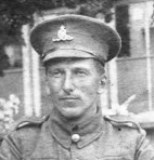
Llewelyn Hulse, Private, 203440, Royal Welsh Fusiliers. Llewelyn was born in Manchester in 1896. He was raised by his Uncle and Aunt, David and Jane Jones, at Penlan, Carrog. He worked at Hendreforfydd Farm and worshipped at the Calvinistic Methodist chapel in Carrog prior to enlisting into the 7th Battalion, Royal Welsh Fusiliers at Newtown on 17 November 1914. The battalion was a Territorial unit, which mobilised for war at Newtown in August 1914, as part of North Wales Brigade, Welsh Division and moved to Conway until the end of the month, before moving to Northampton. In December the Division moved to Cambridge and then in May 1915 to Bedford, where the Division was numbered and the formation became 158 Brigade, 53rd (Welsh) Division. On 19 July 1915 the entire Division sailed from Devonport for Imbros and on 9 August 1915 landed at Suvla Bay. Llewelyn survived the carnage which followed the landings, but by October his health had begun to suffer and he was taken to Malta suffering from enteritis, before being taken back to England. It was almost a year before he was deemed fit enough to return to action and on 23 December 1916 Llewelyn embarked at Southampton for Rouen, joining the 1/4th Battalion, Royal Welsh Fusiliers, which was in France attached to the 1st Division. Within six months he had been taken ill again after being gassed, and was eventually send home in December 1917, before being taken to the Glasgow War Hospital for treatment. During the summer of 1918 Llewelyn was sent from Glasgow to Groesynyd Sanatorium, near Conwy, where he died of tuberculosis on 10 July 1918, aged 21. His remains were brought home for burial in Carrog Baptist Chapel Cemetery.
Caradoc Jones, Private, 9050, Royal Welsh Fusiliers. Caradoc was the son of William and Jane Jones, of 3, Berwyn Street, Carrog. He was a student when he enlisted at Wrexham into the 4th Battalion, Royal Welsh Fusiliers on 25 February 1916. Caradoc was posted to the 3/4th Battalion, Royal Welsh Fusiliers, which was a reserve unit at Oswestry. His health soon broke down, and Caradoc was discharged from the army as medically unfit on 14 June 1916, and was sent to Newport Sanatorium for treatment for pulmonary tuberculosis. Caradoc died of tuberculosis at Newport on 11 August 1916, aged 28. His remains were conveyed home for burial in St. Bride’s Churchyard, Llansantffraid Glyn Dyfrdwy.
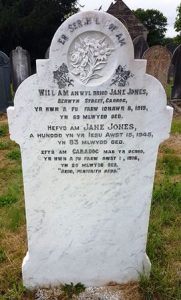
Herman Hill Jones, Private, 1096, Australian Infantry. Herman was the son of Rees Jones and Edith Jones, of Due View, Carrog. He trained as a farmer at Baschurch for several years before emigrating to Australia in September 1911, and found work as a tram conductor at Sydney, New South Wales. He enlisted at Liverpool into the 13th Battalion, Australian Infantry on 26 October 1914 and was posted to C Company. The battalion embarked from Melbourne, Victoria, on board HMAT A38 Ulysses on 22 December 1914 as part of a huge convoy which carried the Australian and New Zealand forces (ANZACS) to Egypt via the Suez Canal. The ANZACS were originally destined for service on the Western Front, but by the time of their arrival in Egypt the Allies had decided to attempt to force the passage of the Dardanelles Straits in order to capture Istanbul and force Turkey out of the war. An attempt by the French and Royal Navy to force the passage using ships failed, so a plan was drawn up to land forces at Gallipoli which would clear the route to Istanbul via the land, and thus allow the ships to safely steam through the straits. As a result a combined force of ANZACS, British and French troops landed at various beaches on Gallipoli on 25 April 1915, but failed to break the Turkish defensive line, and the campaign bogged down into a stalemate. Herman was shot in the chest and shoulder on 29 May, and was evacuated aboard the Hospital Ship Gascon. He died three miles off Gaba Tepe at midday on 30 May 1915, aged 24, and was buried at sea by Reverend Lee Warner. Herman is commemorated on the Lone Pine Memorial, Gallipoli.
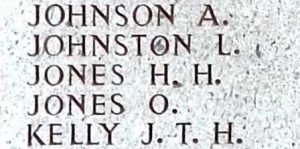
Ronald Madoc Tierney Rose Lloyd, Captain, King’s African Rifles. Ronald was born at Pontefract on 4 August 1884, the son of Major John Rose and Sophie Rose Lloyd. The family owned Rhagatt Hall, Carrog and 14, Sloane Court, London. Ronald was educated at St. Peter’s College, Radley and joined the 3rd York and Lancaster Militia in 1904. He was commissioned into the 2nd Battalion, York and Lancaster Regiment on 16 January 1907 and soon after the outbreak of war was promoted Captain whilst attached to the 2/3rd Battalion, King’s African Rifles. The battalion was attached to the East African Expeditionary Force, and took part in a hostile campaign in German East Africa. Ronald was killed in action during a fight at the Mgeta River on 19 September 1916, aged 32. He was buried in Dutumi, Nkessa, but his grave was relocated after the war, and he now lies in Morogogo Cemetery, Tanzania.
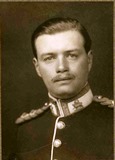
Thomas Herbert Parry, Private, 17680, The King’s (Liverpool Regiment). Thomas was born at Carrog in 1893, the son of Lewis James Parry and Elizabeth Ellen Parry. By 1901 the family had moved to Liscard, Cheshire, where his father had found work on a farm. Thomas worked as a clerk in Wallasey prior to enlisting into the King’s (Liverpool Regiment) at Liverpool on 31 August 1914. He was posted to the 19th Battalion, King’s (Liverpool Regiment), which was raised in Liverpool by Lord Derby, before moving to Grantham to join 89 Brigade, 30th Division. Thomas landed in France with the battalion on 7 November 1915, and the entire 30th Division moved to the Somme area. The Division saw its first major action during the opening of the Somme Offensive, where it captured the village of Montauban on 1 July 1916. The Division then moved to the quieter Givenchy sector to rebuild before moving back to the Somme on 19 September and trained at Vignacourt for several weeks before taking over a section of line at Gird Trench, north-west of Flers, on 11 October, to launch another offensive. On 12 October 1916 the Divisional artillery began an intensive bombardment of the German lines in front, and at 14.50 the Division launched its attack. As the men crossed No-Mans Land, they found the German wire to be uncut by the artillery, and the men were caught in the open where the Germans opened up machine-gun fire onto them. Around 300 casualties were suffered by the 19th Liverpool’s alone. Thomas was among those killed during the day. The 23-year-old has no known grave and is commemorated on the Thiepval Memorial, France. He is not commemorated on the Carrog memorial.
William George Parry, Private, 77595, Royal Welsh Fusiliers. William was the son of William Edward Parry and Elizabeth Jane Parry, of Tirnanerch, Carrog. He worked for the London City and Midland Bank at Machynlleth for eighteen months prior to enlisting at Welshpool into the Denbighshire Yeomanry in October 1916. He served at Beccles and Aldeburgh prior to embarking for France and joined the 16th Battalion, Royal Welsh Fusiliers, which was attached to 113 Brigade, 38th (Welsh) Division. William probably joined the battalion on the Somme, where it had been since relieving the 2nd and 47th Divisions in front of Bouzincourt Ridge at the end of March 1918. The Division held the line here until crossing the flooded Ancre valley on 21 August 1918. In the meantime, the Division took part in several smaller scale attacks against the Germans facing them. On the night of 5 July the 16th RWF relieved the 13th RWF in the right front sector of the Mesnil sector. William was one of three men wounded soon afterwards. He was evacuated to Varennes where he died of his wounds on 7 July 1918, aged 20. William is buried in Varennes Military Cemetery, France. William is not commemorated on the Carrog war memorial, even though he was born and raised in the village.
Owen Roberts, Private, Royal Welsh Fusiliers. Owen cannot presently be identified.
William Samuel Roberts, Private, 12261, New Zealand Expeditionary Force. William was the son of William and Margaret Roberts, of The Post Office, Carrog. He had emigrated to New Zealand as a young man, and lived in Auckland, where he worked as a blacksmith. He enlisted into the New Zealand Expeditionary Force at Trentham on 18 January 1916 after having been unemployed for some time and married Annie Eliza Moseley in Auckland on 22 March 1916. William embarked for Egypt soon afterwards and arrived at Suez on 22 June 1916. He then boarded the SS Ivernia at Alexandria and arrived in Southampton on 7 August, joining the 5th Reserve Battalion, Wellington Regiment. On 28 August William arrived in France, and joined the 1st Battalion, Wellington Regiment, which formed part of the New Zealand Division. The New Zealanders were on the Somme when William arrived, preparing for another offensive there. On 14 September 1916 the Allies launched the Battle of Flers-Courcelette, a mass attack which saw the first use of tanks on the battlefield. William was wounded during the battle, being shot in the right thigh, and was taken to a casualty clearing station at Becordel-Becourt where he died of his wounds on 27 September 1916, aged 33. He is buried in Dartmoor Cemetery, Becordel-Becourt, France.
World War Two, 1939-1945
Robert Astley, Gunner, Royal Artillery. This man cannot be identified, as no-one of that name fell during WW2.
Charles John Chadwick Hindley, Captain, 204106, Royal Army Service Corps. Charles was born at Farnworth on 14 September 1904, the son of Dr John Chadwick Hindley and Kate Hindley (nee Tyler). By 1911 the family was residing in Carrog. Charles was educated at Emmanuel College prior to marrying Edith Deborah Gaughan, of Birkenhead, in 1930. He was commissioned into the Royal Army Service Corps in September 1941 and posted out to the Far East, joining the 25th Indian Division HQ, Indian Army Service Corps. The Division was part of the famed Chindits force, and took part in the campaign in the Arakan. In January 1945 the Division took part in the first large scale Amphibious Operations in South-East Asia, being ferried across the Mayu Estuary to land on the Northern beaches of Akyab Island, and saw ferocious fighting against the Japanese in the coming weeks. Charles was killed in action here on 17 February 1945, aged 40. He has no known grave and is commemorated on the Rangoon Memorial, Myanmar.
Edward Thomas Jones, Private, 4201998, Hampshire Regiment. Edward was born in 1920, the son of John Morris Jones, and of Amilia Jones, of Carrog. He enlisted into the Royal Welch Fusiliers, and was posted to the 2/4th Battalion, Hampshire Regiment. The battalion was split in two during July 1943, one half being attached to the 20th Beach Group during the invasion of Sicily, and the other half being attached to the 21st Beach Group, which took part in the landings at Salerno in September 1943. The assault went in at dawn against stiff opposition so the half-battalion was forced to fight as infantry instead of carrying out its allotted duties, and during several actions from 13 September saw heavy fighting during a series of German counter-attacks. Edward was killed during one such attack on 17 September 1943, aged 23. He has no known grave and is commemorated on the Cassino Memorial, Italy. Edward is not commemorated on the Carrog memorial.
Glyn Thomas, Able Seaman, P/JX 247721, Royal Navy. Glyn was born on 28 October 1920, the son of David and Mary Winniefred Thomas, of 5, Glyndwr, Carrog. He enlisted into the Royal Navy, and after completing his training was posted aboard the destroyer tender HMS Hecla. On 8 November 1942, the Allies launched Operation Torch, an amphibious assault on French North Africa. Glyn’s ship, HMS Hecla, had departed from Simonstown some days previously, carrying supplies for the numerous Royal Navy destroyers which formed part of the invasion fleet, and was in the Mediterranean, off the coast of Morocco, having left Simonstown some days previously. Just after midnight on 12 November 1942, the German submarine U-515 attacked Hecla, firing four torpedoes at her. She was struck in the engine room by one torpedo and ground to a halt, before the submarine sunk her with three further torpedoes an hour later. Glyn was among 279 men killed in the attack. The 22-year-old has no known grave and is commemorated on the Portsmouth Naval Memorial, Hampshire.
